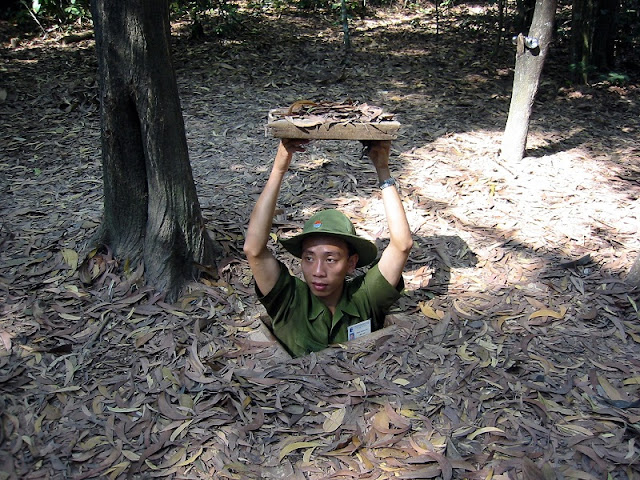A great evidence and memorial site of southern Vietnam’s heroic and heart-breaking war against foreign invaders is found in Cu Chi Tunnel ( Địa đạo Củ Chi), northwest of Saigon (Hochiminh city)
Around 70 kilometers northwest of Saigon, Cu Chi Tunnel is right near the so-called “Iron Triangle” of Southern Vietnam. Both the Saigon River and Route 1 pass through this region which used to serve as major supply routes in and out of Saigon during the war. Hence, the Cu Chi (in Vietnamese: Củ Chi) and the nearby Ben Cat districts had immense strategic value for the NLF (National Front for the Liberation of South Vietnam), contributing to persuading the weary Americans into withdrawal, and has now become a popular tourist attraction for both domestic and international visitors.
Significant historical role.
Significant historical role.
The Cu Chi Tunnel is a huge network of underground tunnels in the Cu Chi district, and part of a larger tunnel network underlying much of Vietnam. It became legendary in the war for facilitating the local guerrillas to win over the American troops. At first, there was no direct order of building the tunnels. However, many patriots who worked secretly in the region and were hidden by local families were caught in the French sweep operations. The locals thus had to dig secret shelters as hiding places for these patriots in the ground around their houses, which was the very early part of the tunnel. Still, the French found out and many more were captured hiding in these secret shelters. Gradually they learned to dig tunnels from one shelter to another, making the Cu Chi complex. Finally, in 1965, the tunnel was completed for the Viet Minh to hide from French air and ground sweeps.
If you are historians, or simply history-desirers, and would like to figure out how hard and heart-breaking the Vietnamese people lived and won over the past war, you should come here and try a real supposed day of the Viet tough life in the underground shelter of Cu Chi by yourself.
Tunnel content.
Tunnel content.
The tunnel network stretches over 250km in total length, and comprises numerous shelters, classes, sleeping chambers, kitchens and wells inside, which were built to house and feed the growing number of residents. Several rudimentary hospitals were created to treat the wounded. Most of the supplies and materials were stolen or scavenged from U.S. bases or troops.
The tough life underground
The tough life underground
Today, tourists flock to the tunnel so as to figure out the tough life endured by the Vietnamese guerrillas during the war time of hiding from the invasion troops. In the gone days, air, food and water were scarce and the tunnels were infested with ants, poisonous centipedes, spiders and mosquitoes. Guerrillas would spend the day in the tunnels working or resting and come out only at night to scavenge supplies, tend their crops or engage the enemy in battle.
Yet, during periods of heavy bombing or American troop movement, they would be sometimes forced to remain underground for many days at a time. Sickness was rampant among the people living in the tunnels; especially malaria, which accounted for the second largest cause of death next to battle wounds. A captured NLF report suggests that at any given time half of a PLAF unit had malaria and that “one-hundred percent had intestinal parasites of significance.” In spite of these hardships, the NLF managed to wage successful campaigns against a conscripted army that was technologically far superior. For such a meaningful historical value, the tunnel is now absorptive to hundreds of thousands of tourists, particularly foreign ones, to come and explore the heroic and harsh period of the Vietnamese guerrillas.
Today’s Cu Chi Tunnel – an important tourism destination
Today’s Cu Chi Tunnel – an important tourism destination
After the nation gained back its independence, this 75-mile-long complex of tunnels has been preserved, and turned into a war memorial park, attracting a huge number of tourists. An activity approved by the majority of tourists is crawling around in the safer parts of the tunnel system. Some tunnels have been made larger to accommodate the larger size of western tourists, while low-power lights have been installed in several of them to make traveling through them easier and booby traps have been clearly marked.
Also, if you join our tour to Cu Chi tunnel, you are offered a meal inside the tunnel, which is exactly the same as what was experienced by the past guerrillas. If you are fond of adventure and secret-exploration, this would be of great captivation to you! More importantly, touring Cu Chi, you would learn more about the war and the resilience of the Vietnamese. Hence, just come and explore a hard but heroic and resilient Vietnam on your own, you will surely never regret!
Cu Chi tunnels are considered one of the can-not-miss Ho Chi Minh tourist attractions with its historical value as a symbol for the iron will of Vietnamese during the war. There are many travel agencies that offer tours from the city to this attraction. Cu Chi tunnels tours are usually designed as half a day or one day trips from Ho Chi Minh city with variable prices to accommodate different level of budgets.

